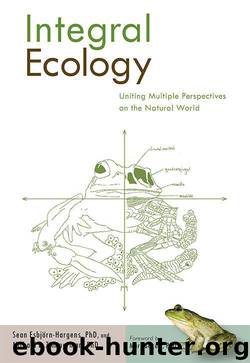Integral Ecology: Uniting Multiple Perspectives on the Natural World by Sean Esbjorn-Hargens & Michael E. Zimmerman

Author:Sean Esbjorn-Hargens & Michael E. Zimmerman [Esbjorn-Hargens, Sean & Zimmerman, Michael E.]
Language: eng
Format: epub
Tags: Life Sciences, Ecology, Nature, Science, Philosophy, Environmental Science, General
ISBN: 9781590307670
Google: aVk_-hy5rNUC
Amazon: 1590307674
Publisher: Integral Books
Published: 2010-01-01T06:00:00+00:00
To truly engage with inhabitants in community-directed work, the development practitioner must be able to “meet people where they are,” in terms of both their value systems and their ways of “making meaning,” building a bridge between existing worldviews and the emerging ones (as described by Kegan, 1994). Combining support and challenge, in each of the three phases of the projects methodology, was significant in creating the conditions for health at each stage of personal and collective development, and for growth through those various stages. In all phases of the methodology, honoring the interior dimensions of the process enabled us to create connections between people and between groups that tetra-arose with the exterior aspects of arriving at outcomes and carrying out solutions.
In this regard, the PAR methodology only went so far. The Integral approach, even as an implicit methodology, was unique compared with other (previous and current) development activities in the community. Rather than fostering dependency and the expectation that external entities (NGOs, government, etc.) would solve the community’s problems, which was particularly the case in Jiquilisco Bay, the Integral framework made room for “self” (the interiors of individuals) in the process of community-directed development. We opened up space for 1st-person perspectives to be shared throughout the project, by engaging all quadrants throughout the phases of the project (figure I.3). Interiors were included during the house-to-house visits, where community inhabitants discussed their lives, families, daily activities, thoughts, and perspectives, and our research team cultivated openness to truly hear what was said. People’s experience was also honored in the focus groups, where we created a trusting and expansive space in which participants shared inner reflections, fears, worries, and hopes. Perhaps in doing so, we created conditions for translation at an existing stage and, for some individuals, transformation to the next stage.
Download
This site does not store any files on its server. We only index and link to content provided by other sites. Please contact the content providers to delete copyright contents if any and email us, we'll remove relevant links or contents immediately.
| Anthropology | Archaeology |
| Philosophy | Politics & Government |
| Social Sciences | Sociology |
| Women's Studies |
The remains of the day by Kazuo Ishiguro(8390)
Tools of Titans by Timothy Ferriss(7811)
Giovanni's Room by James Baldwin(6808)
The Black Swan by Nassim Nicholas Taleb(6763)
Inner Engineering: A Yogi's Guide to Joy by Sadhguru(6440)
The Way of Zen by Alan W. Watts(6288)
Asking the Right Questions: A Guide to Critical Thinking by M. Neil Browne & Stuart M. Keeley(5355)
The Power of Now: A Guide to Spiritual Enlightenment by Eckhart Tolle(5331)
The Six Wives Of Henry VIII (WOMEN IN HISTORY) by Fraser Antonia(5235)
Astrophysics for People in a Hurry by Neil DeGrasse Tyson(5000)
12 Rules for Life by Jordan B. Peterson(4160)
Housekeeping by Marilynne Robinson(4060)
The Ethical Slut by Janet W. Hardy(4040)
Skin in the Game by Nassim Nicholas Taleb(3965)
Double Down (Diary of a Wimpy Kid Book 11) by Jeff Kinney(3924)
Ikigai by Héctor García & Francesc Miralles(3889)
The Art of Happiness by The Dalai Lama(3844)
Skin in the Game: Hidden Asymmetries in Daily Life by Nassim Nicholas Taleb(3722)
Walking by Henry David Thoreau(3681)
